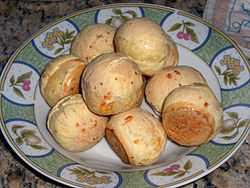Pão de queijo
| Pão de queijo | |
|---|---|
 | |
| Type | Bread |
| Course | Breakfast or snack |
| Place of origin | Brazil |
| Main ingredients | Cassava flour, cheese (usually Minas cheese) |
|
| |

Pão de queijo ("Cheese Bread" in Portuguese) is a small, baked, cheese-flavored roll, a popular snack and breakfast food in Brazil. Its origin is uncertain; it is speculated that the recipe has existed since the eighteenth century in the Brazilian state of Minas Gerais, but it became popular throughout the country after the 1950s. It is also widely eaten in northern Argentina. It is inexpensive and often sold from streetside stands by vendors carrying a heat-preserving container. In Brazil, it is also very commonly found in groceries, supermarkets and bakeries, industrialized or freshly made.
Preparation
Pão de queijo are formed into small balls, around 3-5 centimeters in diameter (though they may be larger). The cassava flour is a powerful starch which is key to the texture of the pão de queijo; unlike other types of bread, pão de queijo is not leavened. Small pockets of air within the dough expand during baking and are contained by the elasticity of the starch paste. Varieties of stuffed pães de queijo with catupiry, hot and melted goiabada, doce de leite and other variations can be found in Brazil.
Availability in Brazil

In Brazil, pão de queijo is a popular breakfast dish and snack. It continues to be widely sold at snack bars and bakeries and it can also be bought frozen to bake at home. In Brazil, cheese puff mix packages are easily found in most supermarkets.
Japan / East Asia
Pão de queijo arrived in Japan with the dekasegi. It is usually made with rice flour instead of the cassava (tapioca) starch.
See also
| Wikibooks Cookbook has a recipe/module on |